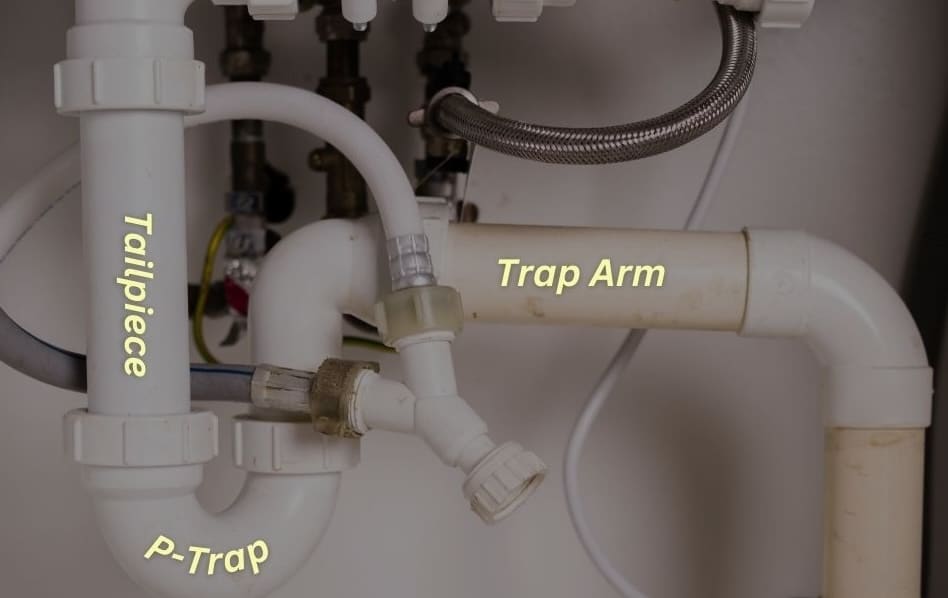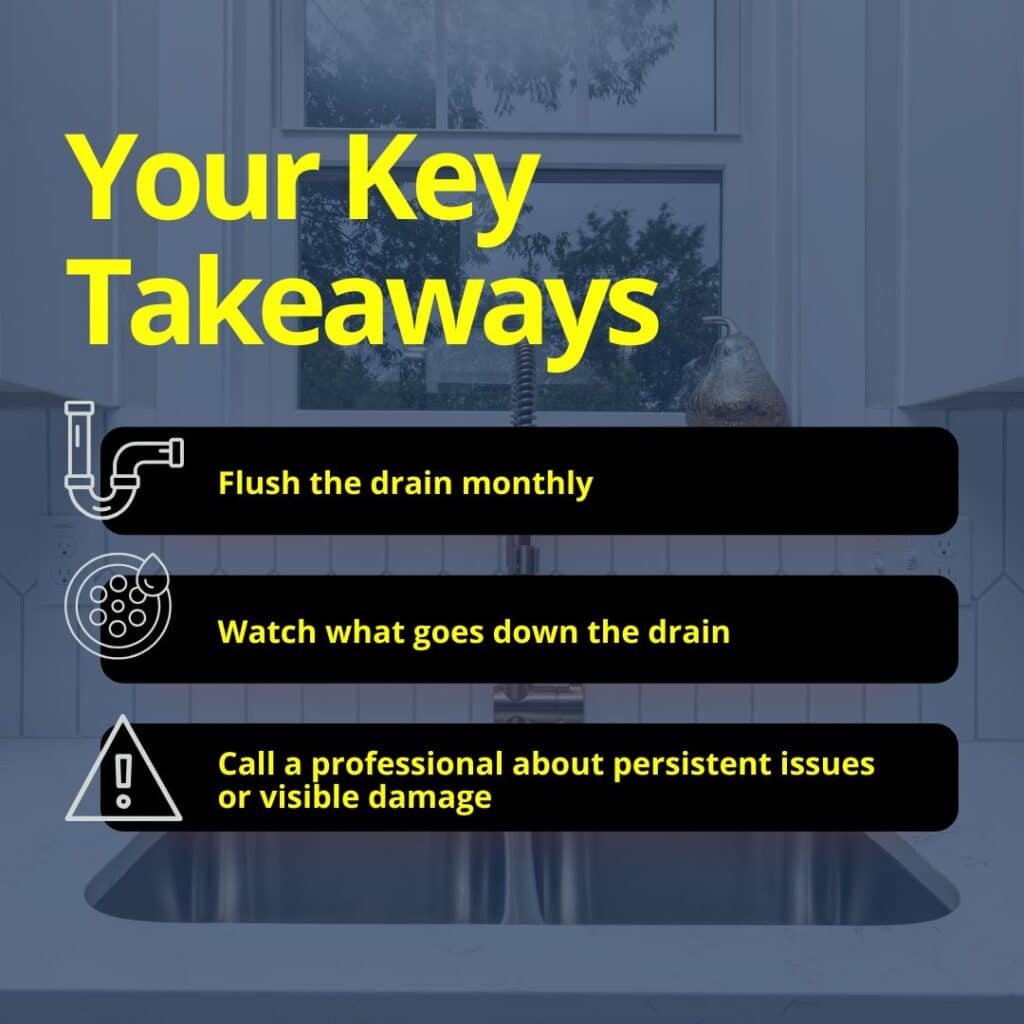A kitchen sink drain relies on several important parts to keep water flowing smoothly. When drainage slows down, leaks appear, or strange odors come from the sink, the problem often starts with one of these components. Knowing how kitchen sink drain pipe parts work can help homeowners spot minor issues before they turn into bigger plumbing concerns.
This guide breaks down six key kitchen sink drain parts and pipe types, explaining their purpose, common problems, and when it’s time for maintenance or a professional inspection.
Tailpiece
This is the vertical pipe that connects the kitchen sink drain to the P-trap—we’ll talk about that part next. The job of the tailpiece is allowing wastewater to flow down into the plumbing system.
It plays a key role in directing water smoothly, preventing leaks, and ensuring proper drainage. Most commonly, the tailpiece might encounter these issues:
- Leaks at the joints can develop if the connection isn’t tight or the washer is worn.
- Corrosion in metal tailpieces can lead to cracks or weak spots over time.
- Improper length can cause misalignment with the P-trap, leading to poor drainage or leaks.
Maintenance Tips
- Tighten the slip-joint connections if water is leaking under the sink.
- If the tailpiece is old or corroded, replacing it with a PVC or stainless steel version can prevent future issues.
- Ensure the tailpiece is long enough to properly connect to the P-trap without strain on the fittings.

Visible under-sink components labeled
P-Trap
The P-trap is the curved pipe under the sink that prevents sewer gases from rising into the home. It holds a small amount of water at all times, creating a seal that blocks odors while allowing wastewater to flow through. If water isn’t draining properly or there’s a foul smell near the sink, the P-trap may be the issue.
Over time, grease, soap residue, and food debris can build up inside the trap, causing slow drainage or clogs. If the trap dries out—common in sinks that aren’t used often—odors may escape.
Leaks can also develop at the connection points, especially if the fittings loosen or the pipe becomes cracked.
Maintenance Tips
- Unscrew the P-trap periodically to remove debris and prevent clogs.
- If odors are coming from an unused sink, running water down the drain will refill the trap and restore the seal.
- Check the fittings and tighten them if there are signs of leaking. If cracks appear, replacing the trap is the best solution.
Trap Arm
The trap arm is the horizontal pipe that connects the P-trap to the home’s drainage system. It directs wastewater from the sink into the larger plumbing network while maintaining proper air pressure to keep water flowing smoothly.
If the trap arm isn’t installed at the correct ¼-inch per foot slope, water may drain too slowly or back up into the sink. A partial clog inside the pipe can also cause gurgling sounds or standing water.
In some cases, an improperly secured trap arm may shift over time, leading to leaks or misalignment with the rest of the plumbing system.
Maintenance Tips
- Ensure the trap arm maintains a slight downward slope to prevent standing water.
- If water drains slowly, a buildup inside the pipe may need to be cleared.
- If the trap arm becomes loose or misaligned, tightening the connections or replacing worn-out washers can help.
Vent Pipe
The vent pipe is a crucial part of a kitchen sink’s drainage system. It regulates air pressure in the pipes, allowing wastewater to flow freely.
Without proper venting, air can become trapped in the plumbing system, causing drainage problems.
If the vent pipe is blocked or improperly installed, you might notice:
- Slow drainage as air pockets disrupt water flow.
- Gurgling sounds when air escapes through the drain instead of the vent.
- Sewer odors if negative air pressure pulls gases from the drain system into the home.
Maintenance Tips
- If the sink drains slowly and makes gurgling noises, the vent may be blocked and need to be cleared.
- Ensuring the venting system meets code requirements can prevent long-term plumbing issues.
Branch Drain Line
The branch drain line is the pipe that carries wastewater from the trap arm into the home’s larger drainage system. It connects to other drain lines before leading to the main drain. If this pipe is damaged or clogged, water from the sink may back up or drain more slowly than usual.
Here’s how you’ll know the branch drain line isn’t functioning properly:
- Standing water in the sink due to a partial or complete blockage.
- Slow drainage in multiple fixtures if the clog affects more than one drain.
- Leaks inside walls or cabinets if the pipe is cracked or improperly connected.
Maintenance Tips
- If the sink drains slowly despite a clear P-trap and trap arm, the branch drain line may need professional snaking.
- Avoid putting grease, food scraps, or coffee grounds down the drain to prevent buildup.
- If water backs up in multiple fixtures, a home inspection may be necessary to check for larger drainage issues.
Main Drain Line
The main drain line is the final exit point for wastewater from the kitchen sink. It connects to the home’s sewer or septic system, ensuring that all used water is safely carried away.
If the main drain line becomes clogged or damaged, it can cause widespread plumbing issues throughout the home. Common warning signs of main drain line problems include:
- Multiple drains backing up at once, not just the kitchen sink.
- Sewage smells or gurgling toilets, which may indicate a blockage.
- Water pooling outside near the sewer line, signaling a possible leak.
Maintenance Tips
- Use enzyme-based drain cleaners regularly to help break down organic buildup.
- Never pour grease, oils, or fibrous food waste down the sink, as they can cause long-term clogs.
- If multiple fixtures in the home drain slowly or back up at the same time, a home inspection can help identify larger plumbing concerns.

Other Recommended Maintenance
Keeping the kitchen sink drain in good condition reduces the risk of leaks, clogs, and costly plumbing issues. Regular maintenance can help extend the life of the drain system and keep it running smoothly.
- Flush the drain monthly with a baking soda and vinegar rinse or an enzyme-based cleaner to prevent buildup.
- Check under-sink connections for signs of leaks, corrosion, or loose fittings.
- Be mindful of what goes down the drain—avoid grease, coffee grounds, and fibrous food scraps.
- Test drainage speed—if water drains slower than usual, addressing the issue early can prevent bigger problems.
When to Call a Home Inspector
Some kitchen plumbing issues are easy to fix, but others could indicate larger problems that aren’t immediately visible.
A home inspector assesses more than just a clogged drain or slow-moving water—they look for underlying issues that could impact the home’s plumbing system and overall condition.
A home inspection is a must if:
- Drainage problems are persistent
- Water stains, soft cabinets, or mold appear under the sink
- Multiple drains in the home are affected
- The home has older plumbing
- A home is being bought or sold
An experienced inspector provides a full-home evaluation, identifying potential concerns that could lead to expensive repairs later on. If issues are found, they can recommend the next steps before the problem worsens.
Conclusion
A kitchen sink drain system is made up of several important pipe types and parts, all working together to keep water flowing smoothly.
Understanding those components can help homeowners spot early warning signs, prevent plumbing problems, and take action before issues get worse. If hidden issues are a concern or you need to schedule a complete home inspection, call PI today.

